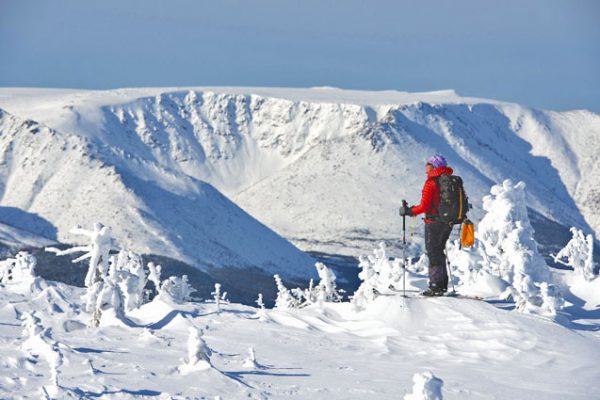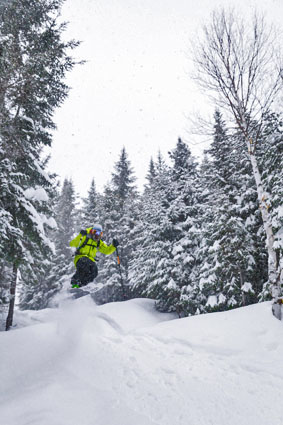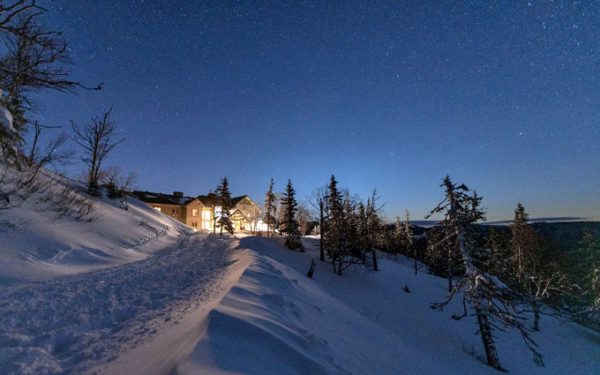Promoting winter travel is a cold job in a heart-warming province

Three Germans, a Netherlander and a Canadian walk into a bar… There we were, meeting in the historic Chateau Frontenac in Québec City with Else, a ski tour operator from the Netherlands (the country with one of the lowest elevations has one-million skiers, a surprise to me), and two German ski journalists, Wolfgang and Jerome. We were waiting for a third German ski journalist, Christian, who was chronically late, an un-Teutonic trait.
“I don’t even think he’s German,” Wolfgang said scoffing
Jerome nodded “He might be French.”
The day before we’d had a glorious outing at Le Massif: blue skies, the residue of a massive snowfall shared by a light mid-week crowd and spectacular views of the St. Lawrence River. We were now packed and ready for the drive to the Gaspésie for some backcountry skiing in the Chic Choc Mountains, the last North American trace of the Appalachians before the range continues across the Atlantic, through Ireland and Scotland, and ends finally in Norway.
Québec Tourism has brought us all here to sample the province as a ski destination. Although older (or technically because they’re older), the hills may not compete in size with Western Canada but they’re not only closer to Ontario and the U.S. Eastern Seaboard, they’re closer to Europe. Quebec’s big sell these days seems to be its unique culture. For the Europeans on our tour, one of the draws was simply the space. Germany has 84-million people in a country that’s one-quarter the size of Québec—with a tenth the population. Staring out at the St. Lawrence from the top of Le Massif, ice piled in jagged heaps, there was no shortage of scale.
When Christian arrived, we piled into our van like schoolchildren. Gilles, our driver, was a wide, solid man with a shaved head who looked like a Bond villain. It took more than seven hours to reach our gîte in the Gaspésie, curving up Hwy 132 which runs along the St. Lawrence River, as much ocean as river at this point. It was a gorgeous drive, passing fishing villages, a lighthouse, a beached submarine and the constant drama of the river. The Europeans asked endless questions, took endless photos.
We talked about where the Dutch ski (52 per cent go to Austria), Germany’s energy grid (despite the country’s groundbreaking foray into renewables they’re still burning more coal than you’d think), how fast cars drive on the autobahn (240 kph) and the French. Not the Québécois, the other ones.
“You don’t want to say anything bad about an entire country…” one of the Germans said.
“But…there is something seriously wrong with the French,” another finished.
Interesting, given they all spoke French and Wolfgang had been married to a Québécoise. He also had no accent whatsoever in English. I asked him about that and he said he’d lived in San Francisco for a few years, one of the few places in the U.S. without a regional accent. We continued to watch the dramatic scenery go by as several languages filled the van.
The next morning we met with our two Québec guides, Guillaume and Philip, who asked if we were familiar with the avalanche gear we’d been given—transceiver, probe and shovel. Wolfgang, the most experienced backcountry skier among us, nodded. They asked if he would tell us all what to do in the event of an avalanche. He outlined the procedure in admirable detail. When the guides were out of earshot, he said, “That’s not what’s actually going to happen.”
“What’s going to happen?”
“Everyone will be disoriented, cold and panicked. They’ll forget which buttons to work on the transceiver to switch to search mode and…”
“We’ll be toast.”
“You’ll be toast.”

Outside it was −26, the coldest day of the year—with a howling wind. I suppose the wind turbines should have been a clue. The Gaspésie has more than 1,000 and we’d seen dozens of them from the highway.
We took a 45-minute snowmobile ride to get to the base of the hill. There were closer chutes but we were hoping to get out of the wind. Still, it was −35 with the wind chill.
“The number is different than the temperature,” Jerome said. Which is to say, the temperature is much worse. The Europeans were admirably stoic. They asked if Canadians felt the cold differently.
Pulling skins apart in this temperature turned out to be a challenge. Two people pulling as hard as possible had no initial effect. The glue had frozen. We were frozen from the snowmobile ride as well, which didn’t help.
“Where is Schwarzenegger when you need him?” Jerome grunted as we pulled.
It took more than 10 minutes to get them all apart and attached, though the effort warmed us up a bit. The skin up through the woods was magical. Winds from the most recent storm had disappeared and in their wake had left at least 20 cm of Chic Chocs powder on the conifers, even more under our skins. We passed a moose trail on the way up.
“What do they eat?” one of the Germans asked.
“Tourists,” I replied with a serious face.
The night before we’d seen a mother and calf on the road while driving in and everyone hoped to see one in the wild. There are 3.5 moose per square kilometre in the Gaspésie, our guide told us, which suggested we’d see about five a day. Bullwinkle remained hidden, however. Running the math and stats in my brain as we slogged uphill, I hoped to see 10 the following day.
It took two-and-a-half hours to skin up and more than an hour for my feet to finally thaw. But at the summit we were briefly warm, partly from the view of the slope below us: virgin powder. Our pause was brief, however. With the wind picking up, we were more than ever exposed. We were informed the wind chill was nearing −50. It was so cold the Germans’ camera equipment froze. And the Germans have very good camera equipment. Wolfgang’s drone would have to remain in his pack.
Philip looked down and said, “I’ll make a trail and you all need to stay to the left of my tracks or you may hit rocks.”
The Germans were smooth, making graceful S-turns. I followed in my allotted untracked powder, picked up some speed—and crashed—one ski disappearing into the snow as if I were watching it go over a waterfall. I righted myself and did what all punters do: blamed my equipment. I cursed the unfamiliar touring binding on my remaining ski, the ski itself (too long) and, most of all, myself. In one run, I had become what I most disdained decades ago—a gorby. A now ancient moniker given to the hordes who came to Banff before Whistler was Whistler: the families and tourists who clogged the hills and fell over in lift lines.
It took 10 minutes to find my ski in the powder, long enough to wonder about survival rates and try to remember the time it takes for exposed flesh to freeze in this temperature (a few minutes, it turns out). Throughout my search and rescue, I recalled that at the bottom, Kahlúa and chocolate were waiting. It was too late in the afternoon for a second run, a relief for more than just me. The temperature was dropping. We snowmobiled back to the hotel where the bar was beckoning.

Else bought the first round because she’d had the first fall. We drank single malt and talked about powder and whisky, and looked at photos of us all where we looked like a more cheerful version of the Franklin Expedition. In the bar we had the happy glow of survivors. Else told me about indoor ski hills in the Netherlands. They have large rotors, similar to the endless wave pools that surfers use. You essentially stay in place and the hill keeps moving while gravity does the rest. They are used mostly for kids to learn how to ski. It sounded quite awful.
“It is,” she said. “But it’s warm.”



